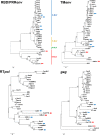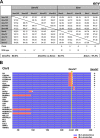Sequence Diversity, Intersubgroup Relationships, and Origins of the Mouse Leukemia Gammaretroviruses of Laboratory and Wild Mice
- PMID: 26865715
- PMCID: PMC4810534
- DOI: 10.1128/JVI.03186-15
Sequence Diversity, Intersubgroup Relationships, and Origins of the Mouse Leukemia Gammaretroviruses of Laboratory and Wild Mice
Abstract
Mouse leukemia viruses (MLVs) are found in the common inbred strains of laboratory mice and in the house mouse subspecies ofMus musculus Receptor usage and envelope (env) sequence variation define three MLV host range subgroups in laboratory mice: ecotropic, polytropic, and xenotropic MLVs (E-, P-, and X-MLVs, respectively). These exogenous MLVs derive from endogenous retroviruses (ERVs) that were acquired by the wild mouse progenitors of laboratory mice about 1 million years ago. We analyzed the genomes of seven MLVs isolated from Eurasian and American wild mice and three previously sequenced MLVs to describe their relationships and identify their possible ERV progenitors. The phylogenetic tree based on the receptor-determining regions ofenvproduced expected host range clusters, but these clusters are not maintained in trees generated from other virus regions. Colinear alignments of the viral genomes identified segmental homologies to ERVs of different host range subgroups. Six MLVs show close relationships to a small xenotropic ERV subgroup largely confined to the inbred mouse Y chromosome.envvariations define three E-MLV subtypes, one of which carries duplications of various sizes, sequences, and locations in the proline-rich region ofenv Outside theenvregion, all E-MLVs are related to different nonecotropic MLVs. These results document the diversity in gammaretroviruses isolated from globally distributedMussubspecies, provide insight into their origins and relationships, and indicate that recombination has had an important role in the evolution of these mutagenic and pathogenic agents.
Importance: Laboratory mice carry mouse leukemia viruses (MLVs) of three host range groups which were acquired from their wild mouse progenitors. We sequenced the complete genomes of seven infectious MLVs isolated from geographically separated Eurasian and American wild mice and compared them with endogenous germ line retroviruses (ERVs) acquired early in house mouse evolution. We did this because the laboratory mouse viruses derive directly from specific ERVs or arise by recombination between different ERVs. The six distinctively different wild mouse viruses appear to be recombinants, often involving different host range subgroups, and most are related to a distinctive, largely Y-chromosome-linked MLV ERV subtype. MLVs with ecotropic host ranges show the greatest variability with extensive inter- and intrasubtype envelope differences and with homologies to other host range subgroups outside the envelope. The sequence diversity among these wild mouse isolates helps define their relationships and origins and emphasizes the importance of recombination in their evolution.
Copyright © 2016, American Society for Microbiology. All Rights Reserved.
Figures







Similar articles
-
Distribution of endogenous gammaretroviruses and variants of the Fv1 restriction gene in individual mouse strains and strain subgroups.PLoS One. 2019 Jul 10;14(7):e0219576. doi: 10.1371/journal.pone.0219576. eCollection 2019. PLoS One. 2019. PMID: 31291374 Free PMC article.
-
Recombinant Origins of Pathogenic and Nonpathogenic Mouse Gammaretroviruses with Polytropic Host Range.J Virol. 2017 Oct 13;91(21):e00855-17. doi: 10.1128/JVI.00855-17. Print 2017 Nov 1. J Virol. 2017. PMID: 28794032 Free PMC article.
-
Endogenous gammaretrovirus acquisition in Mus musculus subspecies carrying functional variants of the XPR1 virus receptor.J Virol. 2013 Sep;87(17):9845-55. doi: 10.1128/JVI.01264-13. Epub 2013 Jul 3. J Virol. 2013. PMID: 23824809 Free PMC article.
-
Origins of the endogenous and infectious laboratory mouse gammaretroviruses.Viruses. 2014 Dec 26;7(1):1-26. doi: 10.3390/v7010001. Viruses. 2014. PMID: 25549291 Free PMC article. Review.
-
The mouse "xenotropic" gammaretroviruses and their XPR1 receptor.Retrovirology. 2010 Nov 30;7:101. doi: 10.1186/1742-4690-7-101. Retrovirology. 2010. PMID: 21118532 Free PMC article. Review.
Cited by
-
Distribution of endogenous gammaretroviruses and variants of the Fv1 restriction gene in individual mouse strains and strain subgroups.PLoS One. 2019 Jul 10;14(7):e0219576. doi: 10.1371/journal.pone.0219576. eCollection 2019. PLoS One. 2019. PMID: 31291374 Free PMC article.
-
SAMHD1 Promotes the Antiretroviral Adaptive Immune Response in Mice Exposed to Lipopolysaccharide.J Immunol. 2022 Jan 15;208(2):444-453. doi: 10.4049/jimmunol.2001389. Epub 2021 Dec 10. J Immunol. 2022. PMID: 34893529 Free PMC article.
-
Recombinant Origins of Pathogenic and Nonpathogenic Mouse Gammaretroviruses with Polytropic Host Range.J Virol. 2017 Oct 13;91(21):e00855-17. doi: 10.1128/JVI.00855-17. Print 2017 Nov 1. J Virol. 2017. PMID: 28794032 Free PMC article.
-
Foamy virus zoonotic infections.Retrovirology. 2017 Dec 2;14(1):55. doi: 10.1186/s12977-017-0379-9. Retrovirology. 2017. PMID: 29197389 Free PMC article. Review.
-
Xenotropic Mouse Gammaretroviruses Isolated from Pre-Leukemic Tissues Include a Recombinant.Viruses. 2018 Aug 9;10(8):418. doi: 10.3390/v10080418. Viruses. 2018. PMID: 30096897 Free PMC article.
References
Publication types
MeSH terms
Substances
Grants and funding
LinkOut - more resources
Full Text Sources
Other Literature Sources
Molecular Biology Databases
Research Materials

